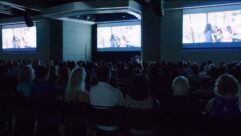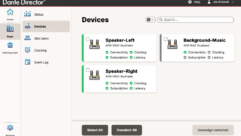
Focus on Corporate AV: Multifunctional AV Network for Businesses
Aug 1, 2008 12:00 PM,
By John DeWitt

Although the oral-healthcare industry can present challenging logistical issues, it’s a market that is largely untapped by the AV industry. Nobel Biocare and Real Digital Media have partnered to leverage the opportunity available in this market, providing dental professionals with a one-source content system for their offices.
Small professional businesses such as dental practices represent a conundrum of opportunity versus challenge for AV providers and integrators.
These prospective clients have money to invest in AV. Dentists and similar professionals typically enjoy higher profit margins and a more consistent clientele than mom-and-pop businesses of similar size. Just considering dentists alone, there are 155,000 in North America. This represents an enormous, largely untapped market. Because they are independent operators, it can be much easier to reach the decision-maker. Moreover, in many respects, they are sophisticated clients who operate sleek, customer-centric, technology-savvy businesses with correspondingly high expectations for AV technology.
On the other hand, independent professionals are a tough sell. They are as frugal as any mom-and-pop business, and they are reluctant to invest in any technology that doesn’t contribute to either increasing their clinical competence, improving their bottom line, or both. Yet, unlike mom-and-pops, they are leery of overt advertising and sales tools. Although they use sophisticated equipment, they have limited inhouse IT expertise. Furthermore, they expect their technology providers — whether equipment technicians or AV pros — to present themselves professionally.
“A lot of big integration companies have done well in the retail and restaurant sector,” says Ray Heiser, managing AV and digital-signage integrator of Creative Marketing and Merchandising Media Solutions (c3ms). “Walking into and working in a professional environment, like a dental office, the level of professionalism and the level of client interface are higher.”
Heiser spent several years figuring out how to bring interactive AV networks into oral-healthcare practices. Working in partnership with Nobel Biocare — which sold nearly $1 billion of dental implants last year — and digital-signage software and player manufacturer Real Digital Media (RDM), c3ms is on track to implement its NobelVision Network AV systems in more than 1,000 North American dental offices by the end of this year.
Launched this last January after two years of development, the NobelVision concept combines innovative business, content, and technology models to resolve the conundrum of selling and implementing AV networks in a professional business setting. Although the NobelVision network is built and deployed upon a modified digital-signage network backbone, it is distinctly different from a typical retail media network. It operates more like a multifunction corporate AV network that provides a combination of educationally oriented corporate communications, consumer entertainment, and distance learning. Moreover, NobelVision’s users are not just dental patients, but also the dentists and their staffs.
Focus on Corporate AV: Multifunctional AV Network for Businesses
Aug 1, 2008 12:00 PM,
By John DeWitt
“There are two sides of the network,” Heiser says. “There’s the direct-to-consumer — or direct-to-patient — side of the network, which runs while the office is open. The second side of the network gets utilized during off-patient hours for a couple of different things. It’s used for continuing-education training, because doctors are responsible for X numbers of hours to keep their accreditation. And beyond areas related to certification, there is a great deal of continuing education and related content that dentists and their staffs are interested in.”
The business model that Nobel and c3ms developed overcomes dentists’ typically conservative approach to technology purchases by not making them pay anything — at least not directly. Instead, Nobel Biocare foots the entire bill for implementing and maintaining the network. All dentists have to do is commit to purchase a certain volume of implants.
The NobelVision business model provides a multilevel payback for Nobel, its dental clients, and patients. Nobel gains a captive audience that it can educate about its products.
“By and large, patients are not aware of our solutions — our implants — which have a 40-year history and a greater-than-97-percent success rate,” says Kevin Mosher, vice president and general manager of Nobel Biocare North America. “We figured that one thing patients do is wait. What if we had something both entertaining and educational that enabled education as they sit there? There are 100 million people missing one or more teeth in America and 37 million Americans wearing at least one denture, according to a Harvard study. There are enough people who are impacted, or who know someone who is, to make this an excellent captive audience.”
This educational content — contained in a 100-minute standard-definition video loop that is updated on a quarterly basis — is combined with more timely content such as movie trailers, general health documentaries, and resort profiles that are updated every two weeks. In addition, there is an AccuWeather realtime sports and entertainment news-ticker feed.
NobelVision represents a comfortable approach to softly promoting dental implants and general oral health. “Dentists are very leery about selling,” Mosher says. “They like to present options, educate the patients, and let them pick among the options — particularly because so much of dentistry is elective.”
In addition to the standard programming, each dentist has a custom profile of his or her practice that plays every 15 minutes to 20 minutes. This feature is enabled by RDM’s Spot Swap feature that creates placeholders in a standard playlist loop for inserting custom content. “It gives the doctor a chance to personalize the content,” Mosher says. “That’s one of the things we liked about the RDM technology — we could have a network, but send custom content to individual locations.”
Beyond driving sales, entertaining patients, and promoting practices, this model saves dentists money. It allows them to order, pay for, and download select continuing-education courses directly to the media player.
“Because these dentists are typically solo practitioners, typically they fly somewhere and take a course,” Mosher says. “This enables them to take it without leaving their practice, so they don’t have to lose money by leaving. It also helps their staffs. A lot of dentists are cheap. They are reluctant to invest in staff education. But if you can do in-office education, the staff can come in an hour early one Friday a month and take a course.”
Given the importance of Nobel’s customer relationships, Nobel, c3ms, and RDM developed a two-stage implementation process. Once Nobel sales representatives have secured an office’s agreement to install NobelVision, c3ms follows with a site survey. After the survery, c3ms schedules one of its national integration contractors — Henkels & McCoy or Contingent Network Services — to handle the install. The goal is to have NobelVision installed within three weeks after the request.
“It really boils down to the ability to execute in the field,” Heiser says. “We do a fairly detailed site survey that garners what type of mount is needed, the office’s Internet connection, and so on, so we can create a scope of work and let the technicians know what they’re looking for. The next step — the actual implementation — can be the challenge. Because we were more concerned with going into the doctor’s office and not creating issues with their existing computer equipment, we gravitated toward contractors that were network-savvy and not just focused on AV integration.”
Beyond the RDM media player, hardware used in the installs includes Chief Manufacturing mounting brackets,West Penn Wire cabling, Gefen for the AV signal, and Linksys routers. NobelVision uses 32in. to 42in. pro displays from Sony, Sharp, and LG. Although the network has HD capability, content likely will remain in SD format for the foreseeable future.
So far, more than 450 Nobel customers have signed up for NobelVision, and initial feedback has been extremely positive.
With the growth and success of NobelVision, the company is now looking at a revenue stream from other sponsors to help offset the cost of the network.
John W. DeWitt is a marketing consultant and business writer based in New Salem, Mass. He can be reached at
.










